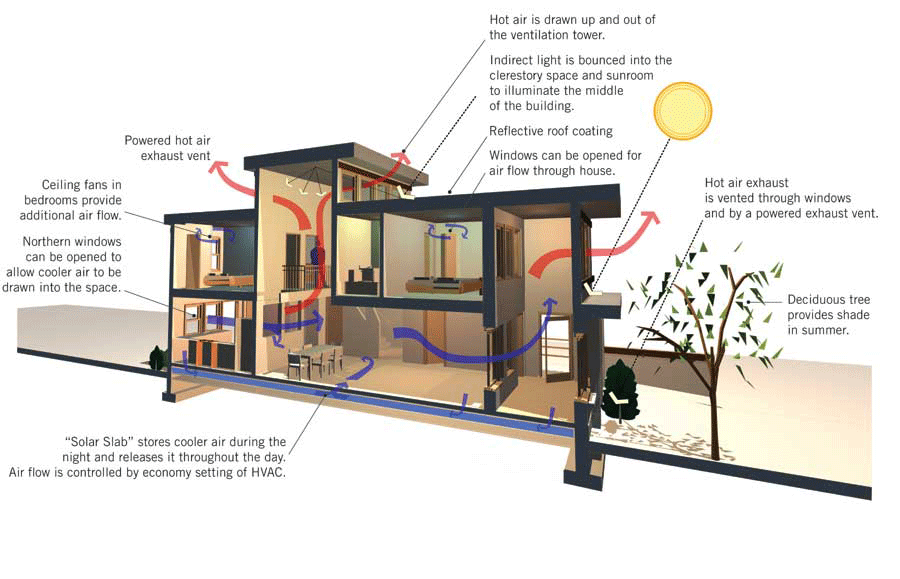How to create a naturally cool building
A couple of weeks ago I was talking to an architect about a new development in our local area. He was explaining the orientation of his proposed buildings and how it would reduce summer heat. Buildings in Britain haven’t traditionally needed air conditioning, but he observed that it was increasingly common. It might be different elsewhere, but as far as he was concerned if a new building needs A/C in Britain, it’s a bad design.
The possibility of air conditioning can make architects lazy. Before it was invented, a whole host of different techniques were used to cool and ventilate a building. But why bother with them if you can make any old box and put an A/C unit in it?
The trouble with this approach is that there are 1.6 billion aircon units operating in the world today already. As the world warms, more people will want them. As more people are lifted out of poverty, more people will be able to afford them. If the growth of A/C continues at the current rate, there will be 5.6 billion units by 2050 – the equivalent of 10 units being sold every second for the next 30 years.
Even without the HFCs problem we’ve discussed this week, every one of those units will need to be powered. The International Energy Agency warns that “if left unchecked, energy demand from air conditioners will more than triple by 2050, equal to China’s electricity demand today.” This ‘cold crunch’ could make climate targets impossible to meet. It would be a sad irony: our desire to keep cool in a warming world could make climate change irreversible. The wrong kind of adaptation would make mitigation impossible.
Given this potential boom in cooling needs, it’s really important to re-learn those techniques for keeping buildings cool. Every well-designed house or office building that doesn’t need aircon represents decades of energy savings.
So what kind of measures are we talking about? Here are a few principles for designing buildings with passive cooling features.

First, it’s important to reduce heat gain through windows. The main problem I have with my house is the summer sun baking through the windows all afternoon. If that same house had been build in a previous era or a different part of the world, it would have shutters. Or it might have a brise soleil, shading lattice-work, or an awning that would block the full sun. The roof could overhang and shade the windows. In some cultures, houses are built with deep porches. There are lots of ways to do it. The important thing is that the strong summer sun isn’t shining straight through and heating the interior.
Heat will still get in of course, and ventilation is the main way to deal with it. If you can open the windows on both sides of the house, it can cross-ventilate and blow heat out of the building. Traditional colonial architecture used internal transom windows – windows above the internal doors – so that the air could circulate even if with the doors closed. Buildings can also use ‘stack ventilation’, where windows at the top vent warm air out through the upstairs or the roof, and draw in cooler air at the bottom. Persian architects used to add wind towers or wind catchers to amplify this effect. Today you might use vents or automated skylights instead, like the Active House does.
My house used to be well shaded by a mature tree out the front, until the neighbour chopped it down. I miss it, especially in heat waves. In hot countries, strategically planting shade trees – or creating shade in other ways, can dramatically reduce cooling costs. One study in the US found that homes that were shaded saved $30 a month in electricity bills, but as the researcher observed, “houses today often do not have shade trees because it’s easier to run an air conditioner.” There are multiple benefits to planting trees, so plant trees to the south and west side and enjoy years of savings as they grow. If they are deciduous, they will provide shade in summer but won’t block the light in winter.
Good levels of insulation will guarantee warmth in winter, but will help to stop a house from overheating too. In traditional Middle Eastern architecture, homes were built with very thick walls, which keep the interior cool. The grass roofs used in many traditional African homes trap pockets of air and provide good insulation. Green walls will cool a building, or climbing plants such as Ivy. Some top performing eco-homes have built-up earth walls that provide insulation in winter, and keep them cool in summer.
Thick walls or earth banks also bring thermal mass into the equation. A bulk of materials such as stone, concrete or earth takes a long time to warm up or cool down. That can help to regulate temperatures. It banks night-time cool to bring temperatures down in the day, warms up over the course of the day and then releases the warmth at night. Thick walls or exposed solid floors can provide thermal mass.
The shape of buildings matters too, and the orientation around each other so that the wind moves in particular ways. Homes built around courtyards have been popular for thousands of years in hot countries, often with a pond or a water feature in the middle to create air flow and evaporative cooling.
There’s a lot more I could say, some traditional methods, some newer, from mud huts to eco-homes. In Britain, we are building homes that ignore these basic principles, and will consequently need mechanical cooling for decades to come. In an age of climate change, that’s really short-sighted, and these passive cooling techniques are going to get more important with every year of warming.
Here’s a useful explanation of many of the main techniques and key terms. It’s from Australia and you’ll want to flip things around for the Northern hemisphere, but the same principles apply.

Professional Recruiter Associates